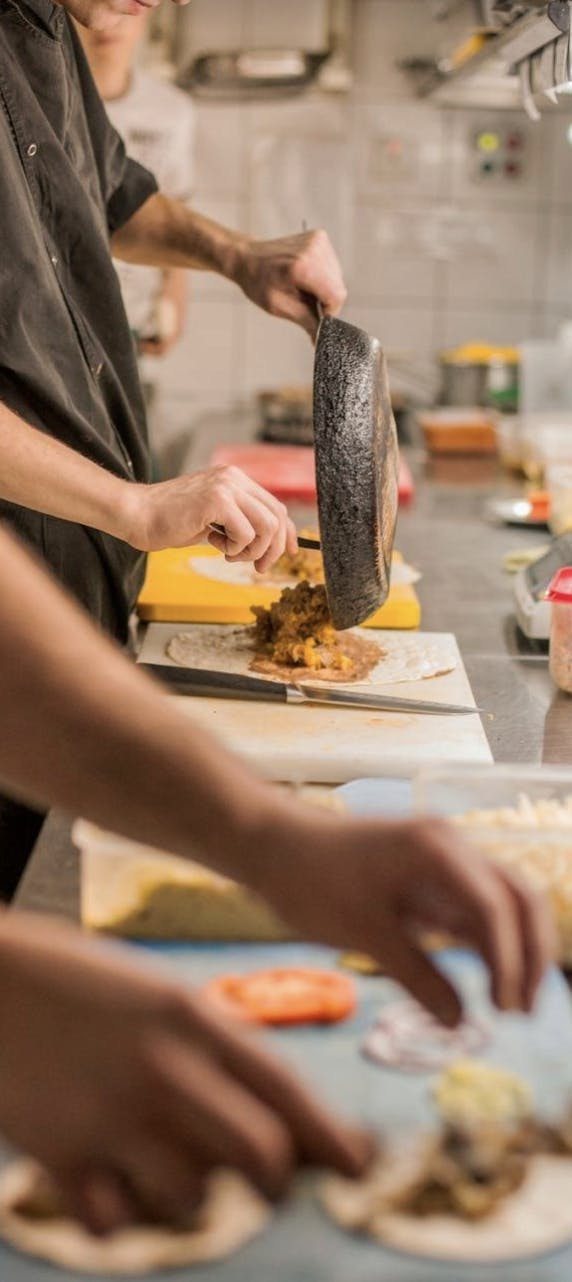Kitchen Hygiene: rules and good practices to apply in your kitchen
Table of Contents
CloudKitchens
How many tacos can be delivered from a 1000sqft restaurant?
The same amount as a 200sqft ghost kitchen.
Maintaining a high standard of kitchen hygiene is essential for ensuring food safety, protecting the health of your customers, and complying with local health regulations. Whether you operate a traditional restaurant or a delivery-focused ghost kitchen, cleanliness and hygiene practices should be a top priority.
In this article, we’ll explore key hygiene rules and good practices that you can implement in your kitchen to create a safer, more efficient environment for your restaurant business!
Why kitchen hygiene is essential for food safety
Kitchen hygiene plays a critical role in preventing foodborne illnesses and ensuring the quality of the food you serve. Poor hygiene practices can lead to contamination, bacterial growth, and the spread of harmful pathogens that can make customers sick.
Ensuring proper kitchen hygiene helps reduce these risks, promotes customer satisfaction, and helps your business avoid costly legal issues or fines due to non-compliance with food safety standards.
Essential kitchen hygiene rules to follow
Personal Hygiene for Staff
Ensuring that kitchen staff practice proper personal hygiene is crucial to food safety. This includes wearing clean uniforms, aprons, and gloves, as well as regularly washing hands, especially after handling raw ingredients, using the restroom, or touching their face.
Hair should be tied back or covered with hair nets, and staff should avoid wearing jewelry that could contaminate food.
Sanitizing Surfaces and Equipment
All kitchen equipment, surfaces, and utensils must be cleaned and sanitized regularly to prevent the spread of bacteria. This includes counters, cutting boards, cooking utensils, and high-contact areas like door handles and refrigerators.
Using food-safe disinfectants ensures that all areas are properly sanitized after food preparation tasks, particularly after working with raw meats or other high-risk ingredients.
Proper Food Storage
Correct food storage is essential for preventing cross-contamination and ensuring that food stays fresh. Food should be stored at appropriate temperatures, with raw ingredients separated from cooked or ready-to-eat items.
Clearly labeling containers and using a first-in, first-out (FIFO) system will help manage inventory effectively and reduce waste due to spoilage.
Waste Management
Proper waste disposal is crucial for maintaining a clean kitchen environment. Trash bins should be covered, regularly emptied, and cleaned to prevent the build-up of food scraps that could attract pests.
Separate bins for recyclable and non-recyclable waste, as well as food waste, will help keep the kitchen organized and reduce the risk of contamination.
Good practices to improve kitchen hygiene
Regular Cleaning Schedules
Implementing a cleaning schedule ensures that every part of the kitchen is cleaned thoroughly and regularly. Assign tasks to employees and create a checklist of cleaning duties for each shift, including sweeping, mopping floors, wiping down surfaces, and deep-cleaning equipment like ovens and refrigerators.
Training Employees
Proper training is key to ensuring that all employees understand the importance of kitchen hygiene and know how to maintain it. Regular training sessions on hygiene protocols, proper food handling, and sanitation practices will help employees stay updated on best practices and ensure consistency in your kitchen.
Pest Control Measures
Pests such as rodents and insects can pose serious health risks in a kitchen environment. Regular pest control inspections and preventive measures, such as sealing cracks, properly storing food, and maintaining a clean environment, are necessary to prevent infestations.
Consider hiring a professional pest control service to conduct periodic inspections and treatments.
Use of Proper Cleaning Products
Not all cleaning products are safe for kitchen use, so it’s essential to select food-safe cleaning agents. Look for products that are specifically designed for use in food preparation areas and ensure that employees know how to use them correctly
Using the wrong cleaning product could result in harmful chemical residues contaminating food.
Read More: How to Start a Food Business?
Kitchen hygiene in ghost kitchens
Unique Challenges for Ghost Kitchens
Ghost kitchens, which operate exclusively for delivery, have unique hygiene challenges. These kitchens often handle high volumes of orders, making it more difficult to maintain cleanliness during peak hours.
The lack of customer-facing operations can also lead to overlooked hygiene practices, as there is no on-site inspection from customers.
Ensuring Regulatory Compliance
Even though ghost kitchens operate behind the scenes, they are still subject to the same food safety regulations as traditional restaurants. Operators must ensure that hygiene protocols, such as regular cleaning, staff hygiene, and food safety, are followed to meet local health standards.
Cloud-based management tools can help ghost kitchens track cleaning schedules, food storage, and other critical hygiene processes to ensure compliance.
Common mistakes to avoid in kitchen hygiene
- Ignoring Personal Hygiene: Employees must follow strict personal hygiene rules, as lapses can lead to contamination.
- Overlooking High-Touch Surfaces: Frequently touched surfaces like refrigerator handles and kitchen switches are often forgotten during cleaning.
- Inconsistent Cleaning Routines: Skipping cleaning tasks during busy times can lead to dirt build-up and increased risk of contamination.
- Improper Food Storage: Failing to separate raw and cooked foods can cause cross-contamination and lead to foodborne illnesses.
- Neglecting Pest Control: Ignoring signs of pests can quickly escalate into an infestation that is harder and costlier to manage.
How CloudKitchens can help your restaurant
Maintaining impeccable kitchen hygiene is crucial whether you operate a traditional restaurant or a delivery-only ghost kitchen. With CloudKitchens, you can simplify your kitchen operations while maintaining high hygiene standards.
Our fully equipped ghost kitchens are designed for efficiency and cleanliness, helping you manage your business with ease. From cleaning schedules to compliance tracking, CloudKitchens supports every aspect of food safety and hygiene, allowing you to focus on delivering great food to your customers.
Ready to optimize your kitchen operations? Visit CloudKitchens to learn how you can streamline your business while maintaining the highest hygiene standards.
DISCLAIMER: This information is provided for general informational purposes only and the content does not constitute an endorsement. CloudKitchens does not warrant the accuracy or completeness of any information, text, images/graphics, links, or other content contained within the blog content. We recommend that you consult with financial, legal, and business professionals for advice specific to your situation.
More insights & stories
There’s more where that came from.
Get in the know and check out our additional insights


